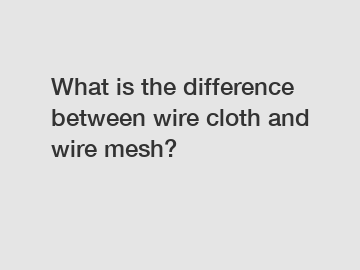What is the difference between wire cloth and wire mesh?
What is the difference between wire cloth and wire mesh?
Wire cloth and wire mesh are two terms that are often used interchangeably, leading to confusion among many people. While both wire cloth and wire mesh are made from interlocking metal wires, there are some fundamental differences between the two. In this article, we will delve into these differences to provide a clear understanding of wire cloth and wire mesh.
1. Construction:

Wire cloth is a woven fabric made by interlacing wires in a plain or twilled pattern. The weaving process creates a mesh-like structure that is sturdy and flexible. On the other hand, wire mesh is produced by welding or weaving wires together, forming a grid-like pattern. Wire mesh can have varying sizes of mesh openings, depending on the application it is intended for.
2. Filtration and Sieving:
One significant difference between wire cloth and wire mesh lies in their intended uses. Wire cloth is primarily used for filtration purposes, where the woven structure is designed to retain particles of a certain size. It is commonly used in industries such as aerospace, oil and gas, and the food processing industry. Wire mesh, on the other hand, is used for sieving applications, where the grid-like pattern allows for the separation of particles based on their size. It finds usage in building construction, mining, and agriculture.
3. Wire Diameter and Material:
The wire diameter and material used in wire cloth and wire mesh also differ. Wire cloth generally uses finer wires, typically ranging from 0.001 inch to 0.080 inch in diameter. The material used for wire cloth can be stainless steel, nickel, brass, or other metals, depending on the required strength and corrosion resistance. Conversely, wire mesh typically uses thicker wires, which can range from 0.080 inch to 0.500 inch in diameter. Steel is the most commonly used material for wire mesh due to its strength and durability.
4. Strength and Durability:
Since wire cloth is woven, it possesses high tensile strength and can withstand heavy loads and pressure. Its interlocking structure makes it highly durable and resistant to wear and tear. On the other hand, wire mesh, particularly welded wire mesh, offers even greater strength as the welded joints provide additional reinforcement. This makes wire mesh ideal for applications that require higher levels of strength, such as security fencing and industrial machine guards.
In conclusion, while wire cloth and wire mesh share similarities in terms of being made from interlocking metal wires, there are distinct differences between the two. Wire cloth is a woven fabric primarily used for filtration purposes, with finer wires and a more flexible structure. Wire mesh, on the other hand, is produced by welding or weaving and is used for sieving applications, offering greater strength and durability. Understanding these differences is crucial in selecting the right material for specific applications, ensuring optimal performance and longevity. So, the next time the terms wire cloth and wire mesh are used, you can confidently differentiate between the two.
For more information, please visit customized epoxy coated mesh manufacturer, carbon steel wire mesh, metal mesh window screen.
258
0
0


Comments
All Comments (0)